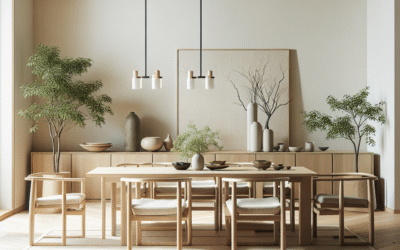
Have you ever walked into a room and felt immediately at peace? This serene atmosphere is a hallmark of Japandi minimalism. In today’s fast-paced world, many people find themselves overwhelmed by clutter. The Japandi style merges the warm, rustic elements of Japanese design with the sleek functionality of Scandinavian aesthetics. In this comprehensive guide, you’ll discover key Japandi minimalist design tips that will make your space feel calm and elegant. Whether you’re a design novice or simply looking to refresh your environment, this article is packed with actionable insights and inspiration. Get ready to transform your home into a minimalistic sanctuary!
Throughout this article, we’ll cover:
- The core principles of Japandi design
- Essential color palettes to consider
- How to choose furniture that aligns with this style
- Tips for incorporating natural elements
- Lighting choices that enhance ambiance
- Frequently asked questions about Japandi design
The Core Principles of Japandi Design
Understanding the foundation of Japandi minimalism is crucial for beginners. This design philosophy emphasizes simplicity, functionality, and beauty.
Harmony Between Cultures
The first principle revolves around harmony between Japanese and Scandinavian aesthetics. This means achieving a balance between warmth and minimalism, inviting tranquility into your home.
Emphasis on Functionality
Another key element is functionality. Each piece of furniture should serve a purpose while contributing to the overall aesthetic. By selecting multi-functional items, you can reduce clutter and enhance your space.
Natural Materials
Japandi design leans heavily on natural materials. Wood, bamboo, and stone are popular choices that bring warmth and texture, aligning with both Japanese and Scandinavian traditions.
Essential Color Palettes to Consider
When it comes to color, Japandi design is all about neutral tones and soft palettes.
Neutral Shades
Colors such as beige, taupe, and ivory create a backdrop that is both soothing and chic. These hues reflect natural light while providing a calm environment.
Earthy Tones
Incorporating earthy tones like sage green or terracotta creates a connection to nature, echoing the organic materials used in Japandi design.
How to Choose Furniture That Aligns with Japandi Style
Selecting furniture is a pivotal aspect of achieving a Japandi aesthetic.
Simple, Clean Lines
Look for furniture with clean lines and simple forms. Pieces should have a modest yet sophisticated appearance that fits seamlessly into your space.
Functional Furniture
Opt for multi-functional furniture, such as coffee tables that can also serve as storage. This promotes both utility and minimalism, keeping your space uncluttered.
Tips for Incorporating Natural Elements
Bringing nature indoors is essential in Japandi design.
Indoor Plants
Plants not only purify the air but also add life to your home. Choose low-maintenance plants like succulents or snake plants that resonate with the minimalistic approach.
Natural Textiles
Using organic textiles will enhance comfort and warmth. Linen curtains, cotton throws, and wool rugs can create an inviting atmosphere.
Lighting Choices That Enhance Ambiance
Lighting plays a crucial role in any design.
Soft, Ambient Lighting
Choose soft lighting solutions that can be adjusted for different moods. Warm, dimmable LED lights create a cozy atmosphere, perfect for a Japandi-inspired space.
Natural Light
Maximize natural light by using sheer window coverings or strategically placed mirrors to reflect light throughout the room.
Frequently Asked Questions
What is Japandi design?
Japandi design combines Japanese simplicity and Scandinavian functionality, emphasizing natural materials and minimalistic aesthetics.
How do I start implementing Japandi style?
Begin by decluttering your space, selecting neutral colors, and incorporating functional furniture and natural elements.
What materials are best for Japandi decor?
Natural materials such as wood, stone, and organic textiles work best in Japandi decor, adding warmth and texture.
Can Japandi design work in small spaces?
Yes! Japandi design is particularly well-suited for small spaces as its minimalist approach emphasizes functionality and opens up the environment.
What are some common mistakes in Japandi design?
Common mistakes include over-cluttering with decor, using bold colors, and failing to integrate natural elements.
Conclusion & Next Steps
In summary, the essence of Japandi minimalism lies in creating a harmonious balance between beauty and functionality. By following these tips, you can start transforming your space into a tranquil retreat that offers peace and simplicity. Ready to dive deeper? Explore our related articles on decluttering and Scandinavian design principles. Your journey to a beautifully minimal home begins now!
Content Disclaimer
The information provided in this article is for educational purposes only. Consult with professionals for personalized advice.
Categories
- Accent Walls & Ceilings (61)
- Art Curation & Gallery (62)
- Bedding Style Trends (68)
- Bedroom Makeover (81)
- Bohemian & Eclectic Styles (58)
- DIY & Budget-Friendly Decor (64)
- Eco-Friendly Design (62)
- Furniture Care (71)
- Home Decor & Design Ideas (162)
- Home Wellness Spaces (59)
- Integrated Outdoor Living (67)
- Japandi Style (61)
- Kids and Nursery Decor (59)
- Living Room Decor (79)
- Mix & Match Techniques (73)
- Modern & Contemporary Design (66)
- Rug Sizing & Placement (73)
- Scandinavian Design Inspiration (20)
- Seasonal Home Decor (79)
- Small Space Solutions (73)
- Wall Art & Painting Tips (77)
Recent Comments
Archives
Product Gallery
-
Large Area Green Rugs for Bedroom Nordic Living Room Decoration Shaped Carpet Irregular Plush Lounge Rug Home Thick Washable Mat
Rated 5.00 out of 5$54.94 – $346.41Price range: $54.94 through $346.41 -
Nordic Style Rugs for Bedroom Morandi Living Room Decoration Carpet Large Area Geometry Lounge Rug Home Cloakroom Non-slip Mat
Rated 5.00 out of 5$39.46 – $597.66Price range: $39.46 through $597.66 -
Irregular Shapes Living Room Decoration Carpet Modern Style Rugs for Bedroom Home Thicken Plush Rug Fluffy Soft Lounge Floor Mat
Rated 4.83 out of 5$55.84 – $347.37Price range: $55.84 through $347.37














